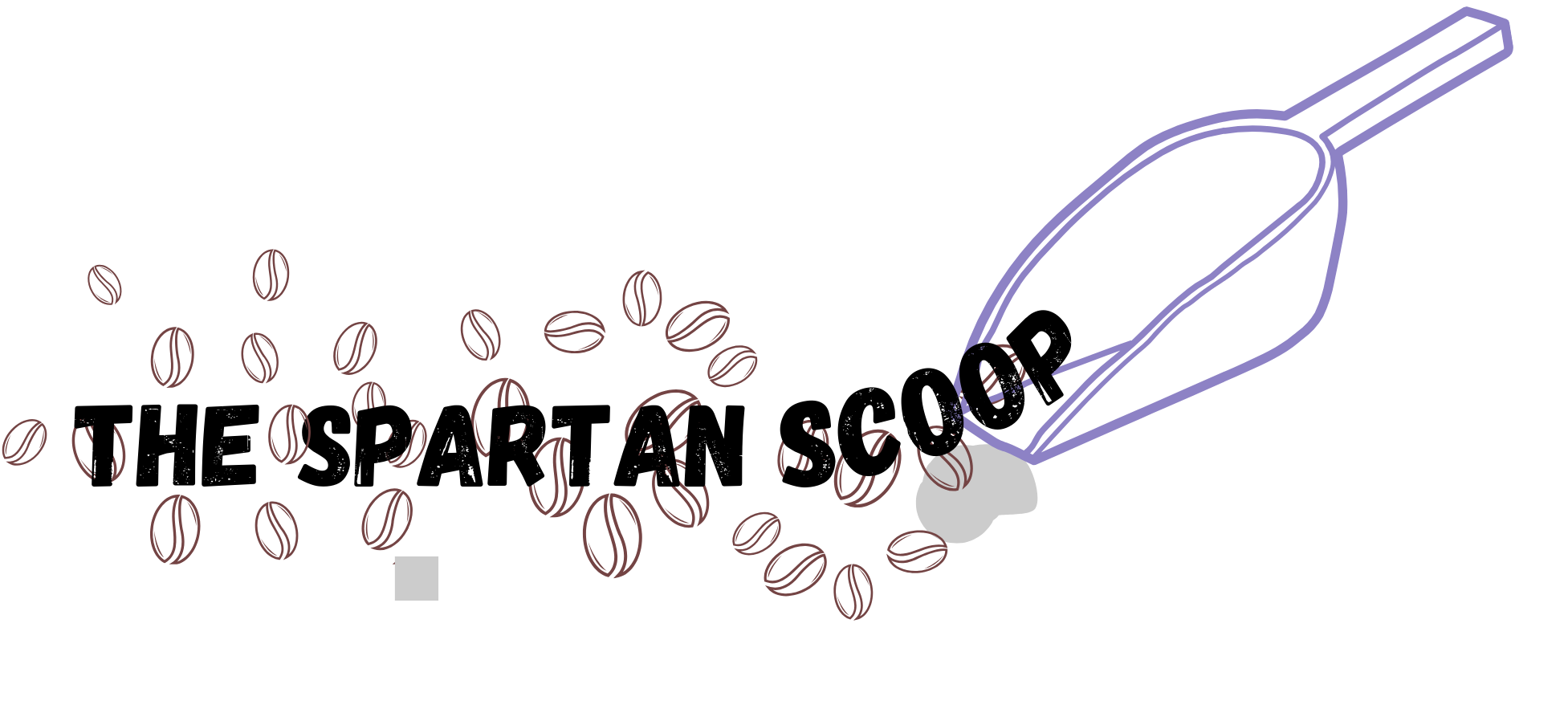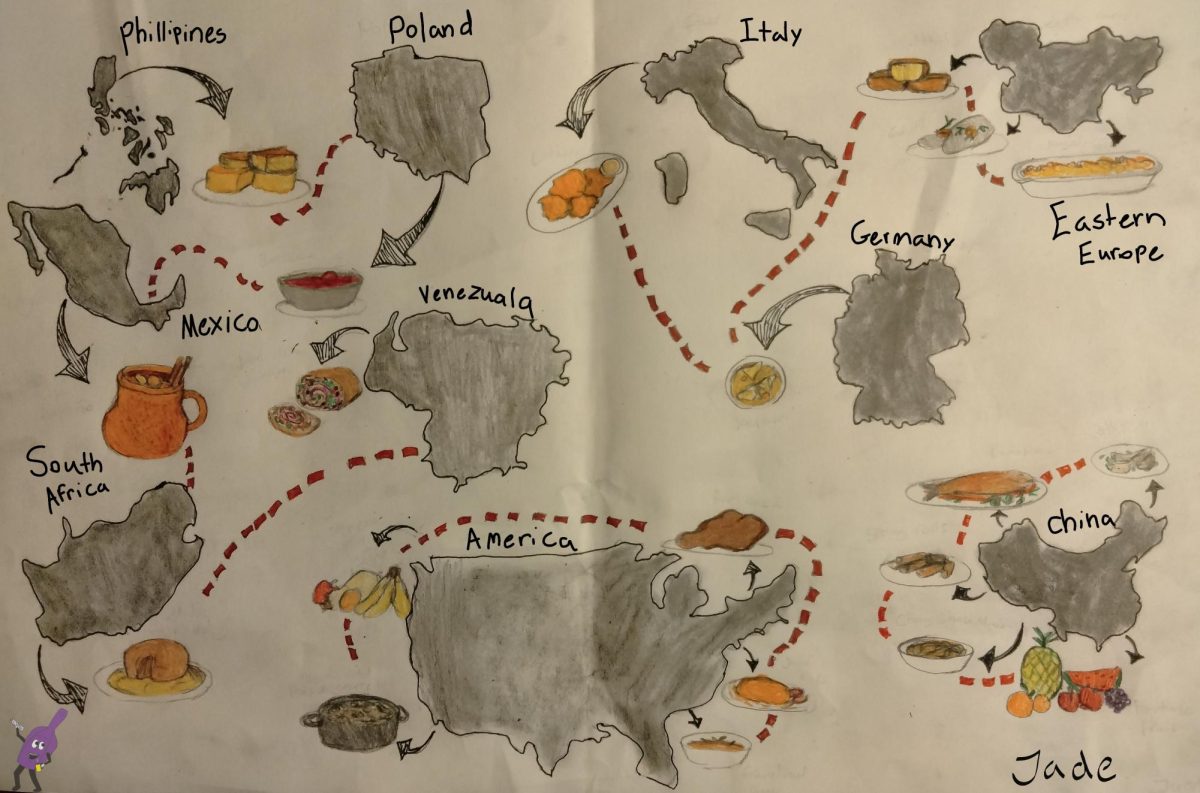HOLIDAY FOOD STAPLES
A map of winter holidays and dishes around the world
Around the world, winter brings in a plethora of holidays, including, but not limited to, Hanukkah, Kwanzaa, Christmas, and Chinese New Year.
Kwanzaa was created in 1966 after the civil rights movement to commemorate forced migration through history and revitalize African-American culture. The birth of America was reliant on slaves being shipped from Africa and stripped of their culture.
Kwanzaa is a time to celebrate family, community, and survival. Unlike many other holidays, there are not strict foods that are eaten for the occasion so much as foods that symbolize a family’s history or geographical location.
For example, families from the South may eat black-eyed peas, potatoes, and other Southern cooking while families with other roots would have different traditions. They do, however, tend to all have Mazao (fresh fruits and vegetables placed on the table to show a grateful harvest) and Muhindi (ears of corn representing children of the family).
Kwanzaa is celebrated from December 26th to January 1st mostly in America with the biggest feast (karamu) on the 6th day to empower communities and join families together.
Continuing down the list we have Hanukkah which is observed for eight days and nights. Being a more widely spread holiday, there are many food staples which have spread to many regions. Hanukkah is a Jewish celebration dating back to 164 BCE to celebrate the successful revolt against the Seleucid monarchy.
Latkes
Latkes are a type of potato pancake that originated in Italy and moved to eastern europe in the 19th century. They are generally made with potatoes but can also be zucchini or other vegetables.
Kreplach
Kreplach originated in Germany. They are small dumplings filled with meat, potatoes, and other fillings. The dough is usually made from flour and water, rolled out thin, filled, and boiled. The most common way to serve them is in a chicken soup.
Knish
Knish originated in eastern Europe and came to America in the 1900s. It consists of a bread-like shell filled with mashed potatoes, meat, cheese and occasionally other vegetables and spices. In 1910 the first Knish bakery was founded in New York and since then it has grown through America.
Gefilte fish
Made from ground fish (usually carp, whitefish, or pike) gefilte fish originated in Europe as a stuffed fish but moved to patties or balls. It is typically topped with sliced carrot and symbolizes luck and protection moving in Jewish homes and is also eaten in Polish Catholic homes on Christmas.
Kugel
A baked casserole; Kugel also originated in eastern Europe. Approximately 800 years ago when it was still developing, Kugel was made as a savory dish from bread and flour but it slowly became sweeter with the additions of milk, eggs, pasta, and occasionally sugar.
Next up is the Chinese New Year. The New year is celebrated differently all over the world, but oftentime it is based on ideas originating from the Chinese New Year. Dating back around 3,500 years it is China’s most important festival and is also known as the lunar new year or the spring festival and of course, as always, food plays a vital role.
Chinese New Year is celebrated between January 21st and February 20th starting with the new moon and lasting 15 days until the full moon hence the name “lunar”. There are many renditions of the New Year origen story which resulted in various traditions such as cleaning one’s house, parades, and special foods.
Jiaozi
Small sycee shaped dumplings, Jiaozi hold a great cultural significance in China and are featured during Chinese New Year and other major festivals. There are multiple origin stories for these dumplings but the most popular places are their creation during the eastern han era by a doctor to help frostbitten ears.
Dayu Darou
Following the patterns we have Dayu Darou which is used to refer to any large fish or meat dish as they combat the day to day dishes which use meats more sparingly. Fish symbolize abundance and having these more lavish dishes is good luck in the new year.
Chun juan
Chun Juan or spring rolls are eaten during the festival as a symbol for wealth and prosperity. They can be fried or steamed and typically have vegetables and meat such as pork inside of the wrapped exterior.
Changshou main
A noodle dish that became popular during the Tang dynasty, Changshou is called the longevity dish and is prepared commonly on birthdays and festive occasions. They call for a long and happy life with longevity being one of the “three abundances” along with fortune and descendants.
Finally we have Christmas. A Christian holiday, it celebrates the birth of Jesus and is thought to date back to the 4th century. Celebrated around the world, there are different traditions and foods in various countries, but the following are some of the most important foods or drinks in five different countries.
Bibingka
A staple in the Philippines, Bibingka is a type of baked rice cake and is usually a feature in breakfast or merienda during the Christmas season. It is baked traditionally in a terracotta oven lined with banana leaves and is commonly sold near churches as it is eaten after the 9th day of Christmas.
Barszcz
Barszcz is a beetroot soup served in Poland for Christmas Eve dinner and is made of meat stock vegetables and beetroot however, on Christmas the meat stock will often be replaced with fish broth to enhance the flavor. It is then served over dumplings or as a hot beverage in a cup.
Ponche Navideño
Ponche Navideno is a Christmas punch made of simmered fruits and spices and has been made in Mexico since it first arrived there from India. It is served on Christmas Eve.
Pan de jamón
Last but not least, we have Pan de Jamon from Venezuela. It is a sweet savory bread roll filled with cheese, ham (jamon), olives, and raisins and appeared in the middle of the 20th century.
All of these dishes hold a cultural significance and story that is different from any other, they have various symbolic meanings and have shifted and grown since their creation. Food has a way of bringing people together and knitting back broken communities.
Humanity has been celebrating history and accomplishments through food for hundreds of years and we will likley continue to do so for many years to come.




